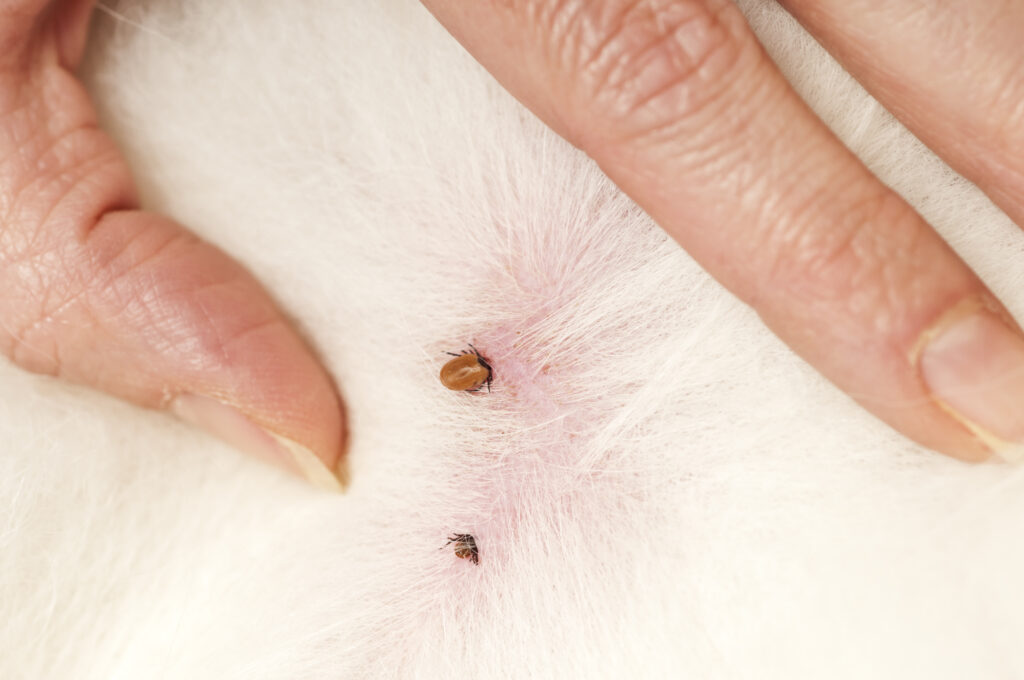Everyone has heard about the dangers of paralysis ticks, but they’re only one species of ticks commonly seen in Australia. Bush ticks are another prevalent tick that you may find on your dog. But what do they look like and what health concerns are associated with them?
What Are Bush Ticks?
Ticks are a type of arachnid that feed on the blood of mammal hosts. Bush ticks prefer cattle as their hosts but do attach to dogs and other animals too.
In addition to feeding on blood, bush ticks can carry blood-borne diseases that may pose a health risk to your dog.
Learn about other types of ticks, such as paralysis ticks or brown dog ticks, here.
What Do Bush Ticks Look Like?
The appearance and size of a bush tick can change depending on how engorged (full of blood) they are. Typically, they’re reddish brown to blue black in colour with legs spread out along the sides of their body.
What Are The Symptoms Of A Bush Tick Bite?
While bush ticks do not produce harmful toxins like paralysis ticks do, their bites can be irritating. And, if the infestation is heavy enough, they can cause anaemia. Signs of a tick bite that you may notice include:
- A tick crater – a wound where the tick’s head was attached.
- Swollen, red skin around the area of the bite.
- Itchiness at the site of the bite
- Pale gums and weakness if there is anaemia caused by a heavy tick infestation
Bush ticks can also carry a deadly blood-borne disease, such as babesiosis. Symptoms of these diseases in dogs can include anaemia, bleeding disorders, fever, lethargy, or weakness.
If you’re concerned your dog has been bitten by a tick, call your local Greencross Vets clinic immediately. Find your closest Greencross Vets clinic here.
For emergency vets after hours, visit our partner emergency hospitals.
How To Check Your Dog For Bush Ticks
To check your dog for ticks, gently run your fingers all over their body. You’re looking for a bump that is the tick itself or a wound or area of redness or swelling that may be a crater where a tick was previously attached.
Ticks can be found anywhere on your dog so don’t forget to check in their ears, under their front legs, in their groin area, and even inside their mouth!
How To Remove A Bush Tick From A Dog
To remove a tick, use either tick removers or your thumb and forefinger to grip it as close to the dog’s skin as possible. Once you have a good grip, firmly pull the tick off the dog’s skin.
Bush Tick FAQs
Where Are Bush Ticks Found In Australia?
Bush ticks like humid climates and areas where they will have access to cattle. They are mostly found on coastal New South Wales, eastern Victoria, Queensland, and coastal areas of Western Australia.
Can Humans Get Bush Ticks From Dogs?
Humans are much more likely to pick up a tick from the environment than from a dog.
Can Bush Ticks Infest Cats?
Read our Ticks On Cats Guide here.
When Is Bush Tick Season?
Tick ‘season’ refers to when ticks are more active. Given the geographical spread of the bush tick, they can be seen all year round.
Are Bush Ticks Still Active In Winter?
Ticks may be less active in winter compared to spring and summer, but they’re still present, particularly in areas that experience milder winters.
Find your local Greencross Vets clinic here or your nearest emergency vet hospital.

 Greencross Vets
Greencross Vets 













